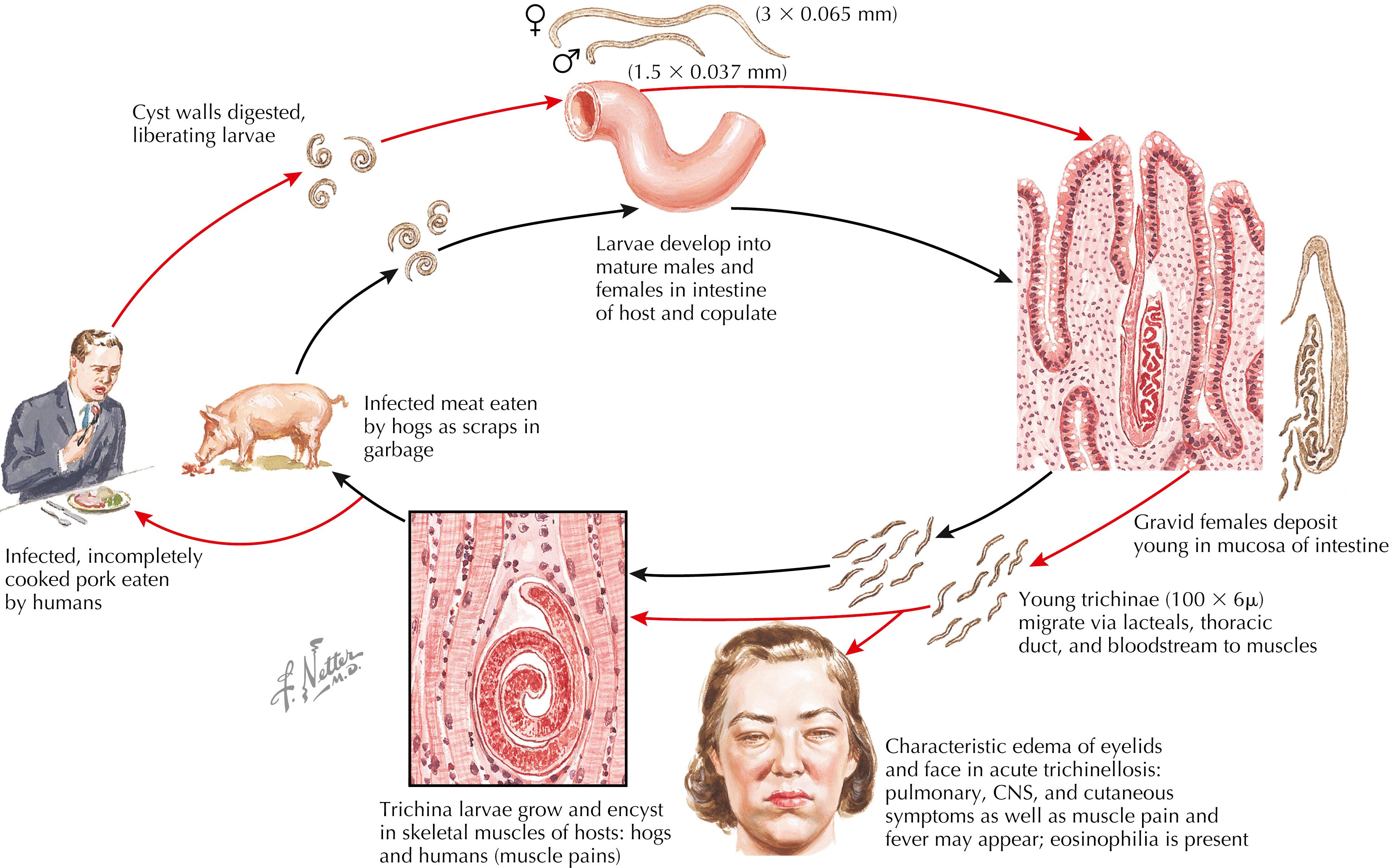Physical Address
304 North Cardinal St.
Dorchester Center, MA 02124
Trichinellosis (trichinosis) is a parasitic infection caused by a roundworm of the Trichinella species. There are eight known species, and all are capable of causing human disease. The most common infections are caused by Trichinella spiralis , which can be found in pigs, rodents, horses, bears, and foxes. Another common species is Trichinella nativa , which infects humans after ingestion of infected bear or dog meat. Humans are incidental hosts. Reservoir hosts include carnivorous animals such as rats, mice, and foxes. Public heath efforts have decreased the risk of infection worldwide but there are still endemic rural areas. The diagnosis is by serology or muscle biopsy, but it can be made without diagnostic tests in the individual symptomatic patient who is part of a documented outbreak. Treatment is with antihelminthic drugs, and prednisone is used to decrease the risk of a systemic inflammatory reaction.
A 34-year old male who had eaten partially cooked wild boar developed abdominal pain and diarrhea 2 days later. Nine days later he presented to the emergency room with severe muscle pain but was afebrile. He was one of 30 people at a party, all of whom became ill, and most were hospitalized with similar symptoms. On physical exam, his legs and arms were severely tender to palpation, but he did not have periorbital edema. The white blood cell (WBC) count was 9.8 × 10 9 /L, and there were 25% eosinophils on the differential count. Serum creatine phosphokinase (CPK) levels were four times the upper reference range. He was treated with albendazole 400 mg twice a day and discharged with a recommendation for continued therapy for 14 days. Seven days after discharge he was readmitted with a temperature of 39°C and recurrent myalgia. The CPK value was normal but the WBC was now 14.0 × 10 9 /L with a differential eosinophil count of 35%. The patient was treated with prednisone 40 mg/d for 5 days and, after 12 hours after the beginning of treatment with prednisone, the fever and symptoms resolved. The albendazole was continued for a total of 14 days. The patient was asymptomatic on follow-up 30 days later. A serologic test for Trichinella was negative, but it was positive in 21 of the other patients who were hospitalized.
COMMENT: The serologic test is very specific but has a relatively low sensitivity, so that a negative test does not rule out the infection. The diagnosis was made because he had compatible symptoms, shared an epidemiologically implicated meal, and the serologic test was positive in most of those who ate the undercooked pork. The worsening symptoms after an initial response to antihelminthic drugs was found in about 50% of patients in one study, occurring as early as 4 and as late as 17 days after the beginning of treatment. The mechanism for the systemic inflammatory reaction is probably largely mediated by eosinophils. It appears prudent to add 5 days of treatment with prednisone to lessen the patient’s reaction to the effects of antihelminthic drug treatment, but the evidence for that recommendation is not based on a randomized controlled trial.
The disease has a worldwide geographic distribution, causing major public health problems in many parts of the world. T. spiralis is found primarily in the United States, South America, Europe, and South Asia, whereas T. nativa , when it is associated with ingestion of bear meat, is found more often in Canada and Northern Asia.
Trichinellosis is common in Thailand and in low- and middle-income countries (LMICs), where many outbreaks are reported each year as a result of consumption of undercooked pork or wild animals. Although the disease is rare in the Western world, outbreaks are reported in Europe and the United States, especially among immigrants who continue to eat undercooked meat or when there are breakdowns of veterinary services. Most infections today are still caused by the ingestion of wild or domestic pork, but cases have been reported after ingestion of infected meat from other animals including horses, bears, walruses, rodents, dogs, lions, panthers, and crocodiles. Game animals as sources of infection have increased greatly in both LMICs and high-income countries; in the United States and other Western countries game animal–associated cases now exceed pork-associated cases, which are rare.
The life cycle includes enteral and parenteral phases ( Fig. 86.1 ).

Humans are infected after eating encysted Trichinella larvae present in raw or inadequately cooked meat. The cyst walls are digested by acid-pepsin digestion in the stomach; larvae are then released and pass into the small intestine. The larvae invade the small intestine’s epithelial wall, molt four times, and develop into adult worms. The males die after copulation, whereas the females produce 500 to 1500 newborn larvae, which are deposited into the mucosa of the duodenal wall over a 2- to 3-week period before being expelled in the fecal stream.
Become a Clinical Tree membership for Full access and enjoy Unlimited articles
If you are a member. Log in here